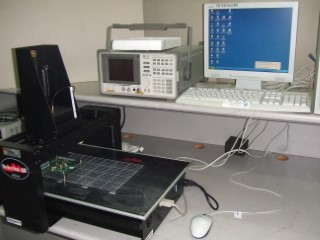Research Facilities and Equipment
Our research is supported by the state of the art facilities, which are catered for both military and civilian EMC measurements. The key facilities are:
- Semi-anechoic Chamber
- Reverberation Chamber
- GTEM Cell
- Shielding Effectiveness Measurement System
- Near-Field EM Scanner for integrated Circuit
- Near-Field EM Scanner for Printed Circuit Board
Semi-Anechoic Chamber
EMERL houses a 10m Semi-Anechoic Chamber for emission measurements and susceptibility tests in compliance to EMC standards.
Semi-anechoic chamber is catering to MIL-STD-461E, FCC and EN full compliance requirement for radiated and conducted emission.
- Physical dimension: 21m by 13m and 9m tall
- Turntable: 4m diameter, withstand 30 tones of static load
- Operating frequency: up to 40GHz
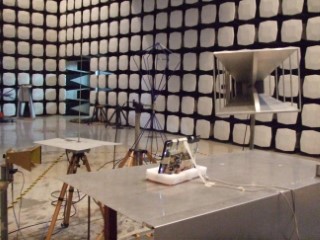
Reverberation Chamber
EMERL houses a Reverberation Chamber for susceptibility tests involving high power fields
Reverberation Chambers are the latest development in EM testing, for performing radiated immunity, radiated emission and shielding effectiveness testing.
The reverberation chamber is a full welded steel chamber in laid with galvanised steel sheet. It has the same electric and magnetic shielding effectiveness as well as a large automatic door as the semi-anechoic chamber. The reverberation chamber is constructed with two stirrers, one vertical and one horizontal. The are used to stir the inevitable standing waves that occur inside the room. RF energy is injected into a corner of the chamber and allowed to reflect off the walls, ceiling, floor and tuner.
Reverberating chamber can also serves as MIL-STD-461C radiated emissions test room, as well as catering to the alternative test methods of the MIL-STD-461E RS103 (reverberation technique) and EN61000-4-21 (reverberation technique). In addition, the reverberation chamber can be configured to carry out both military and commercial conducted emission tests.
- Physical dimension: 8.5m by 12.5m and 6m tall
- Floor loading: 30 tonnes
- Operating frequency: 80MHz to 18GHz
- Generating up to 1000V/m in the test volume
- Test volume: 3m x 4m x 7m
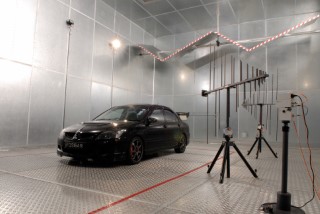
Gigahertz Transverse Electromagnetic (GTEM) Cell
EMERL houses a Gigahertz Transverse Electromagnetic (GTEM) Cell for emission measurements and to conduct susceptibility tests on portable electronic systems.
The Gigahertz Transverse Electromagnetic (GTEM) Cell is capable of performing Electromagnetic Radiation/Susceptibility Tests in accordance to EMC standards:
Electrical Specifications
| Frequency Range | VSWR Typical | Shielding Effectiveness | Field Uniformity |
|---|---|---|---|
| RE Test(9kHz-5GHz) | 1.5:1 | 80dB min (E-field) 10kHz-1GHz | frequency <1 GHz +6dB |
| RS Test (DC-20GHz) | 1.5:1 | 80dB min (E-field) 10kHz-1GHz | frequency <1 GHz |
Physical Specifications
| Outer Cell W/Base Dimension | Maximum Septum Height | Highest Accuracy Transverse Test Surface in Centre of Cell |
|---|---|---|
| (L) 4.0m (13.1 ft) | 900.0 mm | (W) 400mm (15.8 in) |
| (W) 2.2m (7.1 ft) | 34.4 in | (H) 400mm (15.8 in) |
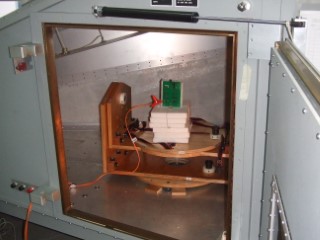
Signal Integrity Measurement
EMERL has latest high-speed equipments to research and analyze into Signal Integrity Issues in high-speed boards.
- Time Domain Reflectometer
- Up to 20 GHz TDR Bandwidth with 15 ps Reflected Rise Time and 12 ps Incident Rise Time
- Lowest Noise for Accurate Repeatable TDR Measurement Results – 600 μVRMS at 50 GHz
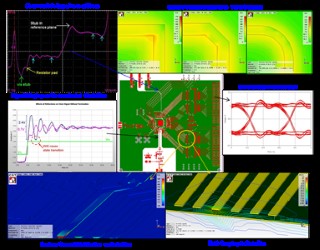
Shielding-Effectiveness Measurement
EMERL has equipment to research and measure shielding effectiveness of material.
The in-house developed cell can be used to measure shielding effectiveness of thin material in the frequeny range from 30MHz to 1GHz in accordance to ASTM D49
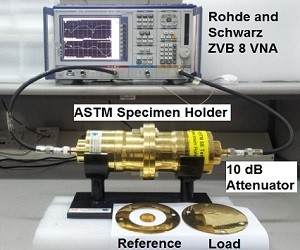
IC and PCB Scanner
EMERL has equipment to research and measure E- and H-Near fields of integrated circuits (IC) and printed circuit board (PCB).
Langer IC Scanner Fs 103 with Near-Field Microprobes
The IC scanner system FLS 103 is particularly suitable to test for PCB and IC. It has a positioning system with 3 or 4 axes to guide the ICR probes and a PCB holder to support the EUT. The measurement is according to norm IEC 61967-3.
The IC scanner uses several ICR probes to measure E- and H-near fields of frequency range from 10MHz to 3GHz. The probes can be moved above the IC surface in all three axes and can be around the z-axis with a resolution of micrometers.
The scanner is controlled via PC with Software ChipScan. The ChipScan software comprises components to operate and control the entire measuring set-up. The mesuring algorithms are carried out in an interactive mode and the results of the measurement are shown in a three-dimensional graphic. The measured data can be exported as excel data.
Technical Data:
| Axes: | x | y | z | z-rotation |
|---|---|---|---|---|
| Measuring range | 300mm | 300mm | 300mm | +/- 180 deg |
| Accuracy: | 10um | 10um | 10um | 1 deg |
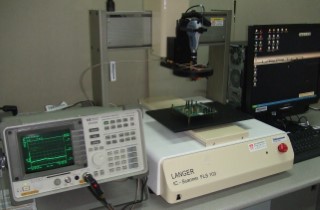
Detectus EMC / Heat PCB Scanner RS321
The patented EMC-Scanner measures the emission from components, cables, PCB's and products. The system consists of an X-Y-Z robot, a spectrum analyzer with near field probe, a GPIB card for communicating with the spectrum analyzer and a standard PC with custom software.
During measurement the near field probe is moved by the robot to predetermined measuring points above the test object. The measuring systems enable the designers to measure the intensity and location of radiation source at a component level. The results of such a measurement can be shown as two or three dimensional coloured maps. The measurements can easily be repeated creating objective, comparative measurement results.
Technical Data:
| Measurable Volume(mm): | 300x200x100 |
|---|---|
| Accuracy: | 1 mm |
| Mini-probe to measure: | E-field (30MHz - 1GHz) H-field (100KHz - 1GHz) RF current (30MHz - 1GHz) |
The Heat-Scanner feature is included in the EMC-Scanner RS321. It is a high-resolution measuring system for anyone wishing to measure temperature accurately and inexpensively. The measurements are presented graphically as either two or three-dimensional images.
| Temperature Range: | 0 - 150 oC |
|---|---|
| Resolution: | +/- 0.3 oC |
| Measuring spot: | 6mm. diameter at a distance of 200mm |
| Response time: | 500ms |
| Emission ratio: | 0,1 - 1,2 |
| Spectral response: | 8 - 14 um |
